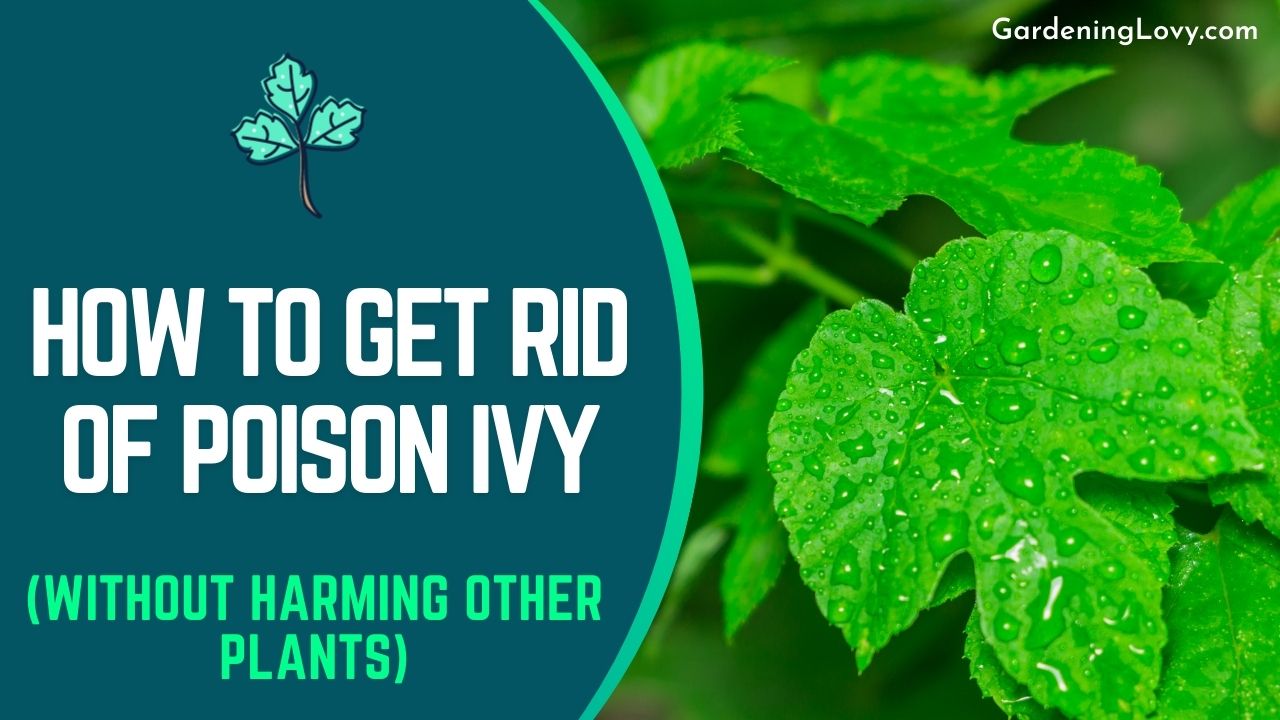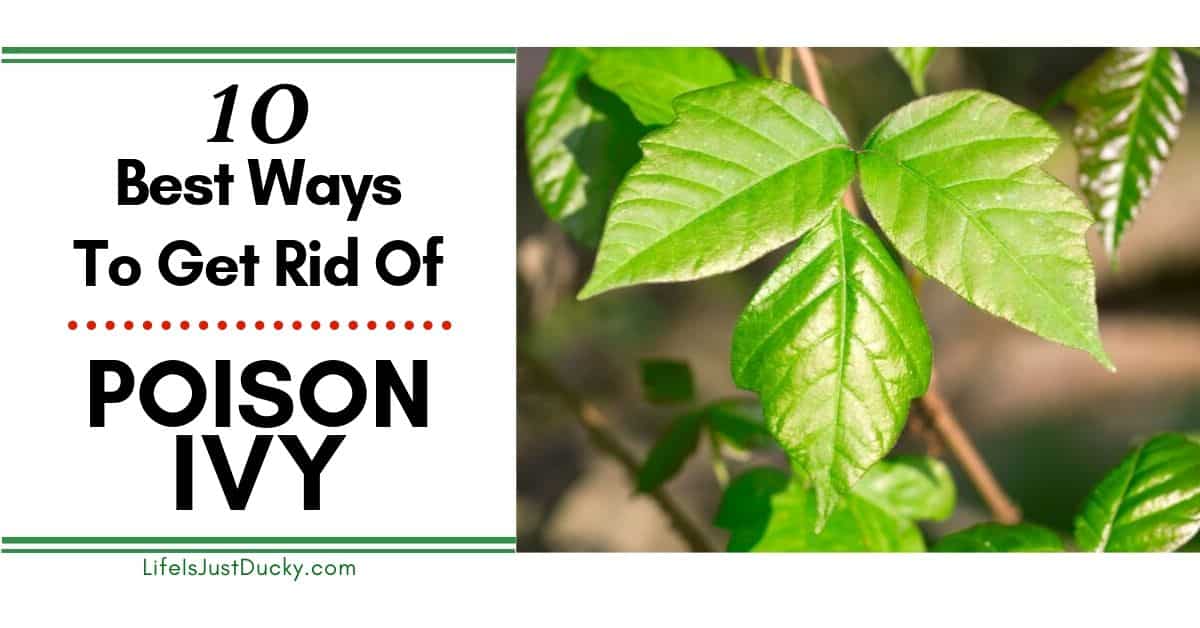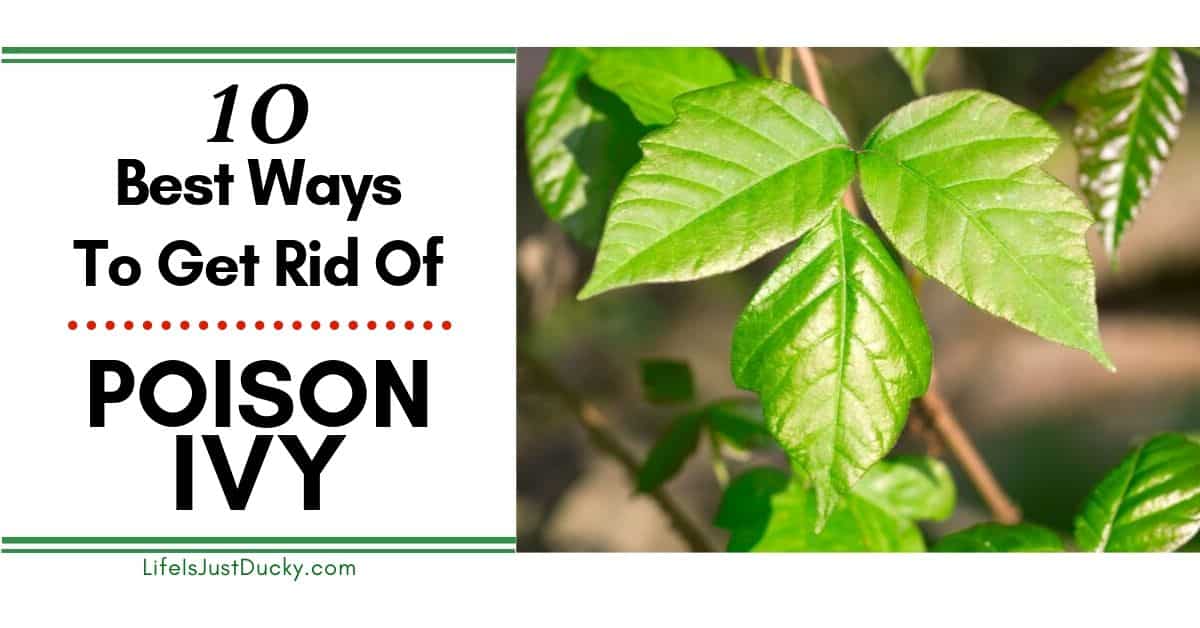Best Organic Solutions for Poison Ivy Removal Without Garden Damage sets the stage for this enthralling narrative, offering readers a glimpse into a story that is rich in detail and brimming with originality from the outset. Poison ivy, with its notorious rash-inducing properties, can be a persistent nuisance in gardens and landscapes.
However, there are effective and eco-friendly ways to eradicate this invasive plant without harming your beloved flora and fauna. This guide will delve into the best organic solutions for removing poison ivy, ensuring a safe and healthy environment for your garden and yourself.
We’ll explore a variety of natural approaches, from homemade remedies to biological control methods, offering practical advice and insights for successful poison ivy removal. We’ll also discuss essential safety precautions, preventative measures, and environmental considerations, empowering you to manage poison ivy effectively and sustainably.
Understanding Poison Ivy: Best Organic Solutions For Poison Ivy Removal Without Garden Damage

Poison ivy is a common plant found throughout North America that is notorious for causing an itchy, painful rash. Its ability to trigger an allergic reaction makes it a nuisance for hikers, gardeners, and anyone who spends time outdoors. Understanding the characteristics, growth habits, and the chemical compound responsible for its irritating effects is crucial for avoiding contact and preventing the rash.
Identifying Poison Ivy
Identifying poison ivy is essential for preventing contact. The plant’s appearance can vary depending on the season and environment. Here are some key features to look out for:
- Leaves:Poison ivy typically has three leaflets, with the middle leaflet being the largest. The leaflets can be smooth or have toothed edges, and they are often shiny. They change color throughout the year, from green in the spring and summer to red, orange, or yellow in the fall.
- Stems:Poison ivy stems are often hairy and can have aerial rootlets that help the plant climb. They are often reddish-brown in color.
- Berries:Poison ivy produces small, white, waxy berries that grow in clusters. The berries are often mistaken for harmless fruits, but they are just as toxic as the leaves and stems.
Growth Habits
Poison ivy can grow in a variety of environments, including forests, fields, and even along roadsides. It is a vine that can climb trees, fences, and other structures. It can also grow as a ground cover.
The Irritant: Urushiol, Best Organic Solutions for Poison Ivy Removal Without Garden Damage
The chemical compound responsible for poison ivy’s irritating effects is called urushiol. Urushiol is an oil that is found in all parts of the plant, including the leaves, stems, roots, and berries. It is highly allergenic, meaning that it can trigger an immune response in most people.
Symptoms of Poison Ivy Rash
The symptoms of poison ivy rash usually appear within 12 to 48 hours after contact with the plant. The rash typically starts as a red, itchy bump or blister. It can spread rapidly and may become painful and swollen.
Complications of Poison Ivy Rash
In most cases, poison ivy rash is a mild and temporary condition. However, in some cases, it can lead to complications, such as:
- Infection:Scratching the rash can break the skin and allow bacteria to enter, leading to an infection.
- Secondary skin infections:If the rash is not treated properly, it can lead to secondary skin infections, such as cellulitis or impetigo.
- Anaphylaxis:In rare cases, people can have a severe allergic reaction to poison ivy, called anaphylaxis. Anaphylaxis is a life-threatening condition that can cause breathing difficulties, swelling of the face and throat, and a drop in blood pressure.
Organic Solutions for Removal
Dealing with poison ivy can be a frustrating experience, but opting for organic solutions allows you to effectively manage this invasive plant while minimizing harm to your garden and the environment. These solutions harness the power of nature to combat poison ivy, offering a safer and more sustainable approach to control.
Natural Herbicides
Natural herbicides, derived from plant extracts or minerals, provide a gentler alternative to synthetic chemicals. These solutions target the poison ivy without harming beneficial organisms in your garden.
- Vinegar:Acetic acid in vinegar disrupts the plant’s cell structure, causing it to wilt and die. Apply undiluted white vinegar directly to the poison ivy leaves and stems. Repeat applications may be necessary, especially for larger plants.
- Salt:Salt dehydrates the plant, hindering its growth.
Sprinkle salt around the base of the poison ivy plant, but avoid excessive application, as it can negatively impact soil fertility.
- Citric Acid:Citric acid, found in citrus fruits, disrupts the plant’s metabolism, inhibiting its growth. Mix a solution of citric acid and water and apply it to the poison ivy leaves and stems.
Homemade Remedies
Simple homemade remedies can effectively control poison ivy using readily available ingredients. These solutions are generally safe and environmentally friendly.
- Boiling Water:Pour boiling water directly onto the poison ivy plants, ensuring the water reaches the roots. This method is most effective for small plants and can be repeated as needed.
- Soap and Water:Mix a solution of dish soap and water and spray it onto the poison ivy leaves and stems.
The soap disrupts the plant’s protective layer, making it more susceptible to environmental factors.
- Salt and Vinegar:Combine salt and vinegar in a solution and apply it to the poison ivy plants. This combination intensifies the effects of both ingredients, promoting plant death.
Biological Control Methods
Biological control methods utilize natural predators or pathogens to control poison ivy populations. These methods offer a sustainable and environmentally friendly approach to managing the plant.
- Insects:Certain insects, like the poison ivy leaf beetle, feed on poison ivy leaves, reducing plant growth. Encourage these beneficial insects by providing habitat and avoiding the use of broad-spectrum pesticides.
- Fungi:Some fungi species are known to cause disease in poison ivy plants.
However, introducing fungi intentionally is complex and requires expert guidance.
Safe and Effective Removal Techniques

Now that you understand the basics of poison ivy and have explored some organic solutions, let’s delve into the practical aspects of removal. This section will provide a step-by-step guide, compare different removal techniques, and Artikel essential tools for a safe and effective process.
Step-by-Step Guide for Organic Poison Ivy Removal
Removing poison ivy requires a methodical approach to ensure thoroughness and minimize the risk of exposure. Here’s a detailed guide:
- Prepare the Area:Before you begin, gather your tools and wear protective clothing, including gloves, long sleeves, and pants. Clear the area around the poison ivy patch to ensure you have adequate space to work and prevent accidental contact with the plant.
Just like finding safe and effective methods for removing pesky gnats from your beloved plants, How to Remove Gnats from Plants Using Safe Methods , tackling poison ivy requires a similar approach. Organic solutions like vinegar or boiling water can effectively eliminate poison ivy without harming your garden’s delicate ecosystem, ensuring a safe and healthy environment for your plants and you.
- Apply Organic Solution:Choose an organic solution like vinegar, salt water, or baking soda and apply it liberally to the poison ivy plants. This step aims to weaken the plant and make it easier to remove. Allow the solution to sit for a few hours or overnight for optimal effectiveness.
- Remove the Plants:Using a trowel or garden spade, carefully dig up the poison ivy plants, ensuring you remove the entire root system. If you’re dealing with large patches, you might consider using a weed wrench for a more efficient removal process.
Dispose of the plants in a sealed plastic bag to prevent further spread.
- Clean Up:Once the plants are removed, thoroughly clean the area where the poison ivy was located. Use a strong soap and water solution to clean your tools, clothing, and any other surfaces that may have come into contact with the plant.
When tackling pesky poison ivy, organic solutions are often the preferred choice to avoid harming beneficial insects and the overall health of your garden. While focusing on eradicating poison ivy, it’s crucial to remember that a healthy ecosystem involves understanding the science behind other common garden pests like gnats, which can be effectively controlled using natural methods like diatomaceous earth or neem oil, as detailed in The Science Behind Gnats in Plants and How to Get Rid of Them.
A comprehensive approach to pest management ensures a flourishing garden, free from both invasive vines and annoying insects.
Dispose of any contaminated materials in a sealed bag to prevent accidental exposure.
- Monitor and Repeat:Keep a watchful eye on the area where you removed the poison ivy. New growth may emerge from any remaining roots. Repeat the removal process as needed until the area is completely free of poison ivy.
Comparison of Removal Techniques
The effectiveness of different removal techniques can vary depending on the size and location of the poison ivy patch. Here’s a comparison of common methods:
Technique |
Effectiveness |
Speed |
Potential for Damage |
|---|---|---|---|
Hand Pulling |
Low (especially for large patches) |
Fast |
High (risk of root fragments remaining) |
Trowel/Spade |
Moderate |
Moderate |
Low (with careful digging) |
Weed Wrench |
High (for larger patches) |
Fast |
Low (if used properly) |
Organic Solutions |
Moderate (requires multiple applications) |
Slow |
Low (if used according to instructions) |
Essential Tools and Equipment
Having the right tools on hand is crucial for a safe and efficient removal process. Here’s a list of essential equipment:
- Gloves:Wear thick, durable gloves that are resistant to oils and chemicals.
- Long Sleeves and Pants:Protect your skin from contact with the plant.
- Trowel or Garden Spade:For digging up the poison ivy plants.
- Weed Wrench:For removing large patches of poison ivy.
- Plastic Bags:For disposing of the plants safely.
- Strong Soap and Water:For cleaning tools, clothing, and surfaces.
- Organic Solutions:Vinegar, salt water, or baking soda for weakening the plants.
Preventing Poison Ivy Regrowth

Preventing poison ivy regrowth is crucial after removal to avoid re-exposure and maintain a poison ivy-free environment. This involves a combination of soil treatment, mulching, and strategic landscape design.
Soil Treatment
Soil treatment aims to eliminate any remaining poison ivy roots that could potentially sprout new plants.
- Herbicides:While herbicides are not organic, they are highly effective in killing poison ivy roots. However, they should be used cautiously and only as a last resort, as they can harm other plants and potentially contaminate the soil.
- Vinegar:White vinegar is a natural herbicide that can be effective in killing poison ivy roots. Diluted vinegar can be applied directly to the soil around the removed poison ivy plant. However, it may not be as effective as herbicides and may require repeated applications.
- Solarization:This method involves covering the soil with clear plastic sheeting for several weeks during the hottest months. The heat trapped under the plastic kills weed seeds and roots, including poison ivy.
Mulching
Mulching helps prevent poison ivy regrowth by blocking sunlight, which is essential for germination.
- Organic Mulch:Wood chips, shredded bark, and compost are effective organic mulches that suppress weed growth. A layer of at least 2-4 inches of mulch is recommended for optimal weed control.
- Landscape Fabric:Landscape fabric is a synthetic material that can be used to block sunlight and prevent weed growth. It is often used in conjunction with mulch to provide a more effective barrier.
Landscape Design
Strategic landscape design can help minimize the chances of poison ivy regrowth by creating a less favorable environment for its growth.
- Planting Dense Groundcovers:Dense groundcovers, such as creeping phlox or pachysandra, can outcompete poison ivy for sunlight and space, making it difficult to establish.
- Avoiding Shady Areas:Poison ivy thrives in shady areas, so planting trees and shrubs that provide ample shade can help prevent its growth.
- Creating Barriers:Physical barriers, such as fences or walls, can be used to separate areas where poison ivy is present from other parts of the landscape, preventing its spread.
Managing Poison Ivy in Persistent Areas
In areas where complete removal is not feasible, ongoing management is necessary to prevent poison ivy from spreading.
- Regularly Monitor:Regularly check for new poison ivy growth and remove any seedlings or young plants immediately.
- Hand-Pulling:For small patches of poison ivy, hand-pulling can be an effective method of removal. However, it is important to wear protective clothing and gloves to prevent skin contact.
- Controlled Burning:In some cases, controlled burning can be used to kill poison ivy. However, this method should only be used by trained professionals and under appropriate conditions.
Environmental Considerations
When choosing a method for poison ivy removal, it’s essential to consider the impact on the environment. While chemical herbicides offer quick results, they can harm beneficial insects, pollinators, and soil health. Organic solutions, on the other hand, provide a safer and more sustainable approach to managing poison ivy.
Comparing the Environmental Impact of Organic and Chemical Methods
Chemical herbicides work by killing plants, but they can also harm other organisms in the ecosystem. They can contaminate water sources, kill beneficial insects like bees and butterflies, and disrupt soil microbial communities. These effects can negatively impact biodiversity and ecosystem health.Organic methods, such as hand-pulling, smothering, and using organic herbicides, are much gentler on the environment.
They target the specific plant without harming surrounding organisms. Organic herbicides, made from natural ingredients like vinegar or essential oils, break down quickly in the soil and do not leave harmful residues.
Benefits of Using Organic Solutions
Using organic solutions for poison ivy removal offers numerous environmental benefits:
- Protection of Beneficial Insects and Pollinators:Organic methods do not harm beneficial insects like bees, butterflies, and ladybugs, which play crucial roles in pollination and pest control.
- Preservation of Soil Health:Organic methods do not disrupt soil microbial communities, which are essential for nutrient cycling and plant growth. They also avoid the buildup of harmful chemical residues in the soil.
- Reduced Water Contamination:Organic methods do not contaminate water sources, protecting aquatic life and human health.
- Promotion of Biodiversity:By minimizing the use of chemicals, organic methods contribute to a healthier and more diverse ecosystem, supporting a wider range of plant and animal life.
Creating a Healthy Garden Ecosystem
To discourage the growth of invasive plants like poison ivy, consider these tips for creating a healthy garden ecosystem:
- Promote Plant Diversity:A diverse range of plants can compete with invasive species for resources, making it harder for them to establish themselves.
- Maintain a Healthy Soil:Healthy soil with good drainage and a balanced nutrient profile can support strong, healthy plants that are better able to resist invasive species.
- Control Weed Growth:Regularly remove weeds, including poison ivy seedlings, to prevent them from spreading.
- Mulch with Organic Materials:A layer of organic mulch can suppress weed growth and improve soil health.
- Use Integrated Pest Management (IPM):IPM strategies combine cultural, biological, and chemical controls to manage pests and diseases in a sustainable way.
Conclusion
By understanding the characteristics of poison ivy, implementing organic removal techniques, and employing preventative measures, you can reclaim your garden from this pesky plant without resorting to harsh chemicals. Embrace a holistic approach to gardening, prioritizing natural solutions and fostering a thriving ecosystem that discourages the growth of invasive plants.
Remember, a healthy garden is a harmonious one, where nature’s balance prevails.
Query Resolution
How long does it take for poison ivy to die after treatment with organic solutions?
The time it takes for poison ivy to die varies depending on the chosen organic solution, the size of the plant, and environmental conditions. Some methods, like using boiling water, may provide faster results, while others, like using vinegar, might require a few weeks for complete eradication.
Is it safe to compost poison ivy after removal?
It is not recommended to compost poison ivy, as the urushiol oil can remain active in the compost and potentially cause a rash. It’s best to dispose of the removed poison ivy in a sealed bag or burn it (if permitted in your area) to avoid spreading the oil.
